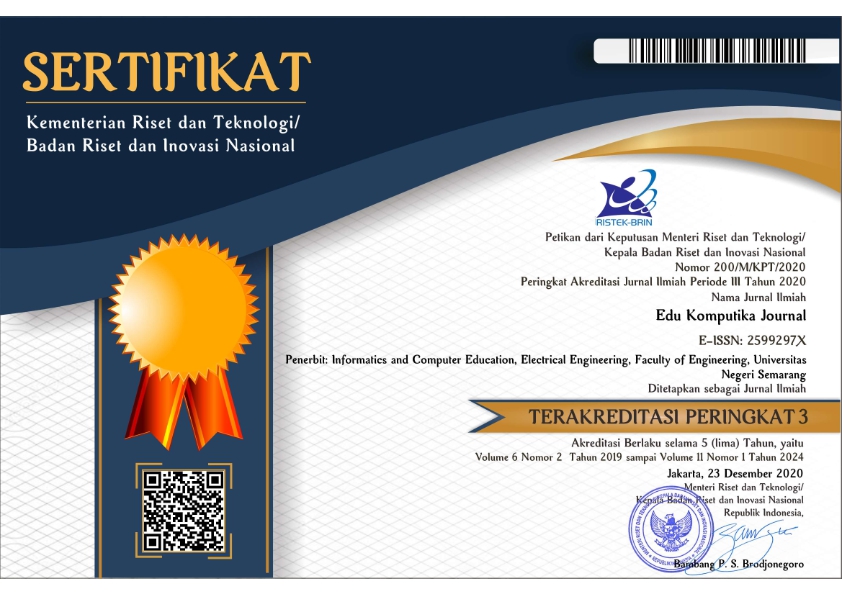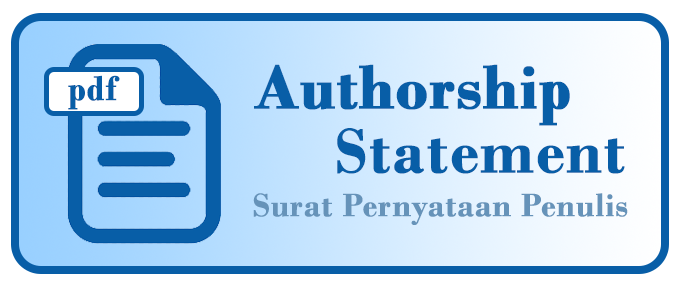Pengembangan Game Math Story Problems Menggunakan RPG Maker MZ untuk Anak 4-7 Tahun
Abstract
This study aims to produce and test the feasibility of an RPG (Role Playing Game) Math Story Problem created using the RPG Maker MZ software. The research method used is the Research and Development method using research stages (1) needs analysis, (2) design, (3) implementation, (4) validation, (5) revision and (6) product testing. The requirements analysis stage is used to analyze competency standards, hardware and software specifications. The design stage includes storyline design, display design, flowchart and character creation in the game. The implementation stage is the stage of realizing the design into an actual product. The validation stage is carried out to assess the feasibility of the game that has been designed and created which is then determined by the experts to get the criticism and suggestions needed for improvement so that the game becomes even better. The trial phase is carried out by direct application in children's learning. This test was conducted on respondents aged 4-7 years using a questionnaire. The data obtained were processed by descriptive analysis to determine the level of feasibility of the game. The results of data analysis showed that the feasibility level according to material experts was 96% which was included in the very feasible category and children as users was 83.75% which could be categorized as very feasible.
References
Atifi, M., Mamouni, A., & Marzak, A. (2017). A Comparative Study of Software Testing Techniques. In A. El Abbadi & B. Garbinato (Eds.), Networked Systems (pp. 373–390). Springer International Publishing.
Fuqoha, A. A. N. (2015). PENGEMBANGAN GAME RPG (ROLE PLAY GAME) SEBAGAI MEDIA PEMBELAJARAN BERBASIS GUIDED INQUIRY PADA MATERI SEGIEMPAT DAN SEGITIGA UNTUK SISWA KELAS VII. http://anjasmara.uny.ac.id/Record/eprints-23089
Hermawan, D. P., Herumurti, D., & Kuswardayan, I. (2017). Efektivitas Penggunaan Game Edukasi Berjenis Puzzle, RPG dan Puzzle RPG Sebagai Sarana Belajar Matematika. JUTI: Jurnal Ilmiah Teknologi Informasi, 15(2), 195. https://doi.org/10.12962/j24068535.v15i2.a663
Indriyani, T. W., & Suryanto, A. (2021). Markerless Augmented Reality (AR) pada Media Pembelajaran Pengenalan Komponen Transmisi Manual Mobil. Edu Komputika Journal, 8(1 SE-Articles). https://doi.org/10.15294/edukomputika.v8i1.44484
Nadifah, L. U. (2018). Pengembangan game “PADUKA. exe” berbasis RPG Maker MV sebagai media belajar mandiri pada materi Fungsi Komposisi. http://digilib.uinsby.ac.id/id/eprint/25518
Nisrina, S. H., Rokhmawati, R., & Afirianto, T. (2021). Pengembangan E-modul Berbasis Project Based Learning (PjBL) pada Mata Pelajaran Animasi 2 Dimensi dan 3 Dimensi untuk Meningkatkan Hasil Belajar Peserta Didik. Edu Komputika Journal, 8(2 SE-Articles). https://doi.org/10.15294/edukomputika.v8i2.48451
Rifaldi, A., Kurniawan, P., Manikowati, M., & Mulwinda, A. (2021). Lestari Media Pembelajaran Interaktif Tumbuhan. Edu Komputika Journal, 8(1 SE-Articles). https://doi.org/10.15294/edukomputika.v8i1.42346
Roohullah Jan, S., Tauhid Ullah Shah, S., Ullah Johar, Z., Shah, Y., & Khan, F. (2016). An Innovative Approach to Investigate Various Software Testing Techniques and Strategies. International Journal of Scientific Research in Science, Engineering and Technology, 2(2), 682–689.
Sandercock, G. R. H., & Cohen, D. D. (2019). Temporal trends in muscular fitness of English 10-year-olds 1998--2014: An allometric approach. Journal of Science and Medicine in Sport, 22(2), 201–205.
Sari, D. P. (2010). Pengembangan media pembelajaran matematika berbasis ICT yang berkualitas. Seminar Nasional Pascasarjana, 979, 1–8.
Setiyani, S., Sumarwati, S., Sagita, L., & Fadhlurrohman, D. (2021). The incredible boong gi: Educational game RPG for mathematical understanding ability. International Journal of Education and Learning, 3(2), 76–93.
Sobel, M. A., & Maletsky, E. M. (2004). Mengajar matematika. Jakarta: Erlangga.
Tegeh, I. M., & Kirna, I. M. (2013). Pengembangan Bahan Ajar Metode Penelitian Pendidikan dengan ADDIE Model. Jurnal IKA, 11(1), 16. https://ejournal.undiksha.ac.id/index.php/IKA/article/view/1145
Watkins, J. (2002). Testing IT: an off-the-shelf software testing process. Computing & Control Engineering Journal, 12, 271–272. https://doi.org/10.1017/CBO9780511997310
Widodo, A., & Utomo, A. (2021). Media Pembelajaran Taksonomi Hewan Berbasis Augmented Reality dengan Fitur Multi Target. Edu Komputika Journal, 8(1 SE-Articles). https://doi.org/10.15294/edukomputika.v8i1.40611
















